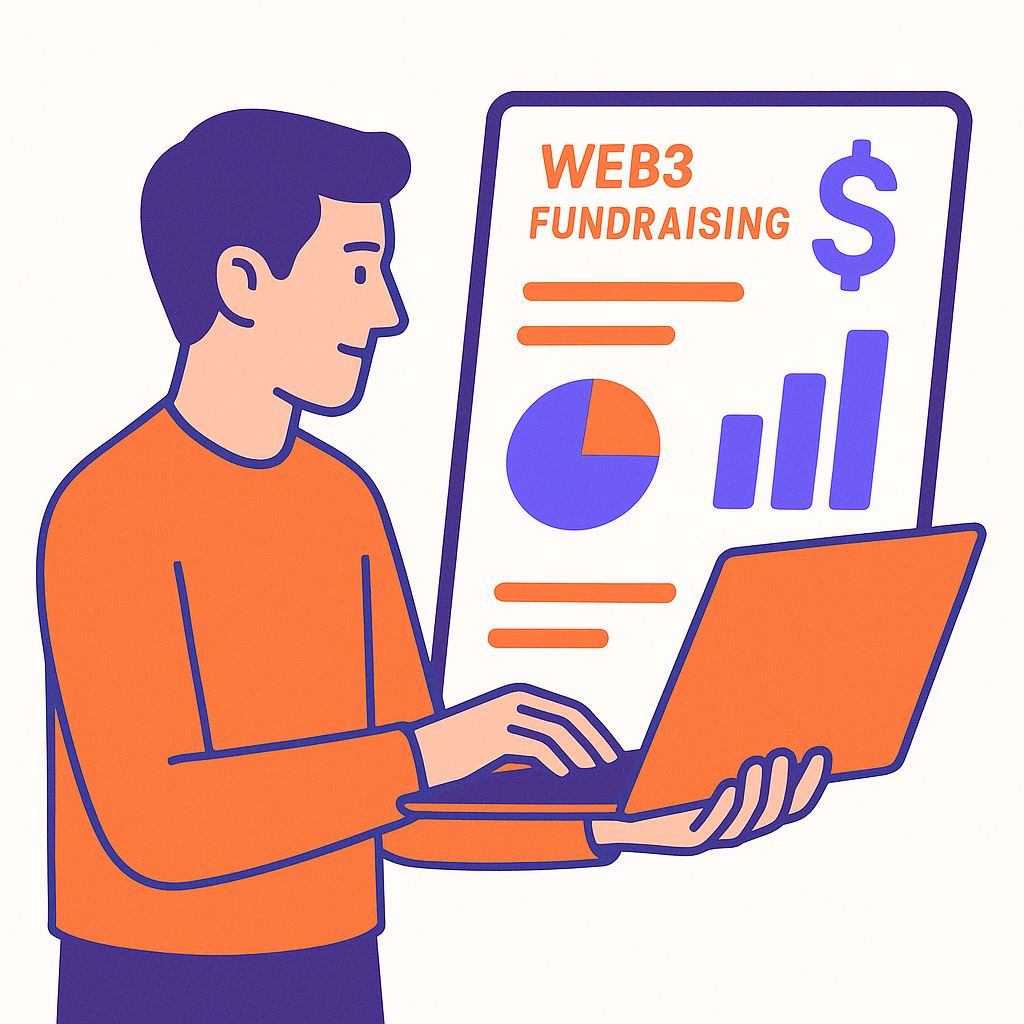

Web3 Product-Market Fit for B2B: What Investors Want to See
Startup investors want clear proof that your product matches what the market needs. Most companies take about 2 years from their original idea to reach this sweet spot of product-market fit.
The typical startup launches an alpha product within 1-3 months. The real work starts after that, and founders usually need 9-18 months to find their true product-market fit. This longer timeline explains why web3 investors need solid evidence before they invest. Proving web3 product market fit helps you raise funds because it substantially lowers the risk for potential investors.
This piece dives into what web3 investors look for when they evaluate B2B startups. You'll learn how to find product market fit using real metrics instead of buzz. Investors focus on key signals: growing user numbers, strong user retention, and steady revenue growth.
We'll also show you how to handle the ups and downs that come with finding the right product fit.
What Web3 Investors Look for in B2B Startups
Web3 investors assess startups through a unique lens that combines traditional business knowledge with specialized blockchain technology and decentralized ecosystem expertise.

Understanding investor mindset in Web3
Web3 investors use a distinct assessment framework that merges traditional venture metrics with blockchain-specific considerations. Traditional VCs value team quality and market potential, but Web3 investors emphasize token design, governance mechanisms, and approaches to progressive decentralization.
The dynamic and liquid nature of token investments makes Web3 investors look for shorter investment return timelines compared to traditional markets. They focus on several critical factors:
- Technical architecture and scalability potential
- The founding team's blockchain-specific expertise
- Token value accrual mechanisms
- Community growth strategies as early adoption signals
- Regulatory strategy and compliance approach
These investors get into not just business models but also a complete ecosystem strategy that accounts for various stakeholders, including developers, users, and token holders.
Why product-market fit is non-negotiable
The fundamental truth remains despite Web3's revolutionary technology: building a successful Web3 product requires finding product-market fit. This isn't about following fleeting hype cycles or building for speculative frenzies. The focus should be on creating products that solve real problems and deliver lasting value.
Web3 startups should prove their solution addresses a major customer pain point, and customers should show clear willingness to pay. Investors want to see broad adoption across various customer segments rather than limited reach in a narrow niche.
That’s where C-Leads comes in. We help Web3 teams go beyond assumptions and hype by establishing direct communication with their target audiences through the targeted outreach. By testing different market segments and building real conversations with prospects, we surface genuine interest, feedback, and unmet needs, giving founders the insight needed to sharpen their value proposition and find true product-market fit. Our approach doesn't just generate leads, it uncovers who your product is really for, and what they’re actually willing to pay for.
Many Web3 projects have failed because they took a "build it and they will come" approach instead of focusing on genuine user needs. Market downturns make this mindset particularly harmful, as less than 15% of startups who received seed capital end up securing Series A funding.
How PMF reduces perceived risk
Product-market fit makes startups appear less risky to investors. Founders who show PMF prove they've reduced market rejection risk and found a scalable business model.
B2B Web3 startup investors look for specific signals to confirm PMF:
- Customer validation: Evidence through user testimonials and feedback
- Early revenue: Proof of willingness to pay
- Usage patterns: High engagement and retention metrics
The strongest signal appears when customer pull replaces company push. This change leads to rapid growth in key metrics like revenue, user engagement, and retention.
💡Web3 startups can make fundraising easier in a competitive landscape by showing solid evidence of PMF that reduces investor's perceived risk.
Proving Product-Market Fit with Real Signals
Real proof matters more than big promises when showing product-market fit to Web3 investors. Let's get into the actual signals that convince backers your B2B startup has found its market.

Customer validation and testimonials
Your product shows the clearest sign of market fit when marketing changes from push to pull. Customers search for your product, keep taking it, and tell others about it enthusiastically. This natural word-of-mouth shows you're creating real value.
Web3 founders should talk with potential users while developing their products. Web3's connected nature puts everyone just one connection away. This makes collecting targeted feedback the quickest way forward. You can employ platforms like X and Farcaster to find experts whose adoption patterns others follow.
The Sean Ellis Test gives you numbers you can measure. You've likely achieved product-market fit if 40% of users would be "very disappointed" without your product. This measurement cuts through the noise and shows real need.
Early revenue and willingness to pay
B2B Web3 startups can prove their value best through money. Your early customers' readiness to pay is the ultimate proof of validation.
You need honest talks with future clients about pricing basics:
- Their current payments to existing vendors (for replacement products)
- The cost of hiring full-time employees for similar work
- The money value of lifestyle improvements your solution brings
Smart early-stage companies often set high initial prices and give special discounts to early adopters. This shows confidence and helps people start using the product.
Retention and usage patterns that matter
Investors look beyond simple numbers like total transactions or wallet connections. Daily active users (DAU) to monthly active users (MAU) ratios give you real insights. A ratio above 30 shows emerging product-market fit. Numbers below 10 point to big problems, while anything above 60 means exceptional growth.
Cohort retention analysis shows if users find lasting value in your product. You should watch users at risk (inactive for 30-60 days) to spot potential dropouts early. Track "saved users" who come back after breaks to understand which features bring them back.
Standard Web3 metrics like Total Value Locked (TVL) and transaction counts can mislead if used alone to show network health. Investors now want a clearer picture of who uses your product and how they use it.
Metrics That Matter in Web3 Fundraising
Smart product investors in the changing Web3 digital world now look past surface-level metrics to spot B2B startups with real market traction. Your success in getting funding depends on understanding which numbers actually matter.

Beyond TVL: what metrics investors trust
Total Value Locked (TVL) used to be the ultimate measure of Web3 project health. Excessive focus on this metric has created manipulation and twisted incentives.
Today's investors care about:
- dApp revenue - Direct income from user fees shows real service demand
- Monthly Active Users (MAU) - Reflects ecosystem activity and user adoption
- Network transactions - Measures real activity, though investors prefer long-term averages instead of short-term spikes
- Developer engagement - Your platform's active developers signal technical strength and ecosystem growth
The transparent nature of on-chain data gives investors a significant edge. They value knowing how to verify claims about user activity, transaction volume, and protocol health independently.
User growth vs. user quality
In stark comparison to this traditional startup thinking, Web3 success doesn't always need huge user numbers.
Key metrics that show user value include:
- User Lifetime Value (ULV) - Shows total revenue each user generates throughout their platform journey
- Customer Engagement Score (CES) - Combines various user actions to spot "super fans"
- Retention Rate - Active wallet percentage over time, where DAU/MAU ratios above 30% point to emerging product-market fit
💡In Web3, you don't need a million users. You need a thousand aligned believers.
Stretching PMF to new segments
Web3 startups often spot opportunities in related market segments over the last several years.
Here are 3 effective ways to expand:
- Institutional markets: These provide steady capital flow during market swings
- Strategic community reboots: These restore momentum through fresh user involvement
- Enterprise partnerships: These cut down customer acquisition costs through B2B approaches
Web3 projects with the strongest traction are willing to experiment while keeping their core vision intact. The most successful teams stay flexible and adapt their product roadmap based on user feedback and market trends. This approach helps them refine their path toward lasting product-market fit.
Conclusion
Web3 investors no longer chase surface-level excitement. They just need solid proof before investing their capital. Startups should focus on meaningful metrics that show real traction instead of temporary hype. Customer testimonials, pricing acceptance, and strong retention rates make a better case than vanity metrics or speculative token movements.
On top of that, successful founders know quality beats quantity in building Web3 communities. A thousand active users create more lasting value than millions of passive ones. This new view helps teams focus their resources on their most valuable community members.
Your Web3 sales need a boost? Let's talk. We'll show you how to attract ideal clients and scale your brand automatically.
The strongest Web3 projects treat PMF as an ongoing experiment rather than a final destination. Teams should be ready to change direction when needed. They must talk openly with stakeholders and keep improving based on user feedback. Markets change, regulations move, and user needs transform in the faster-moving Web3 space.
Web3 product-market fit ended up being about creating real value that lasts whatever the market conditions. B2B Web3 startups can show their worth to careful investors with the right metrics, willingness to adapt, and focus on solving real problems. This disciplined approach builds foundations for lasting growth instead of short-term success tied to market cycles.
Get 7 times more prospects than the average competitor




